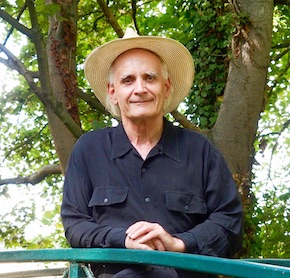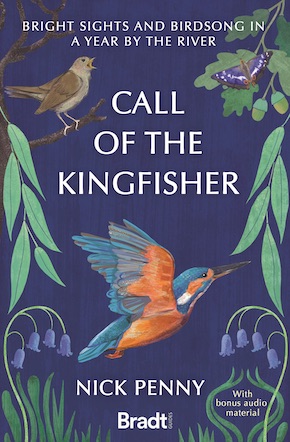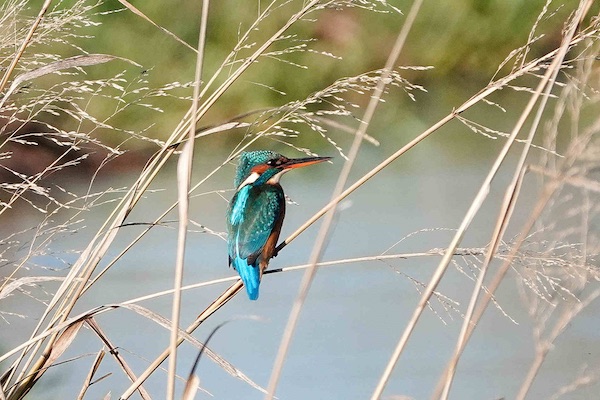Fairies and angels, the old nest, purple emperors
by Nick Penny1 JULY: I was joking to a friend the other day that after a year watching kingfishers I’d be well equipped to start looking for fairies, or even angels. I felt there were similarities in that they might be all around us but most people have never seen one. I reckoned that the waiting, seeing and believing skills built up while birdwatching might come in useful.
Joking apart, it’s interesting that fairies and angels are often depicted with wings. Like birds, they may appear and disappear in a mysterious way. Like kingfishers, they may also have a supernatural light and glow about them.
This morning I was reading about Carl Jung, the great Swiss psychoanalyst who devoted his life to unpicking the meanings of myth, magic and dreams. In his 1913 book Memories, Dreams, Reflections, Jung talks about dreaming of a character called Philemon, a kind of imaginary spiritual mentor. In the dream Philemon appeared as an old man, with the horns of a bull and the wings of a kingfisher, flying across the sky. Jung later did a painting of the image in which Philemon resembles an angel. The dream gained even more significance for him when he unexpectedly found a dead kingfisher in his garden a few days later.
There’s a sense of awe and celebration in the way poets have written about kingfishers. In ‘The Progress of Spring’, Tennyson describes them as “the secret splendour of the brooks”. W.H. Davies declares that: “It was the rainbow gave thee birth.” Gerard Manley Hopkins starts one of his most famous poems with the luminous first line: “As kingfishers catch fire, dragonflies draw flame.” In his Four Quartets, T.S. Eliot uses the image of light on a kingfisher’s wing as he reflects on special moments, the still points in a spinning world.
For a bird that flies so fast, it’s interesting that kingfishers are often associated with calm. In Ancient Greek mythology Alcyone was transformed into a kingfisher after her husband Ceyx died in a shipwreck. When she made a nest on a beach it was nearly swamped by a storm. Her father Aeolus, god of the winds, calmed the waves to save it. Kingfishers became associated with periods of good weather, especially if they happened at an unusual time of year.
Another association with weather was the folk belief that if a dead kingfisher is hung up on a string indoors its beak will always point in the direction of the wind. Shakespeare refers to it in King Lear, where he writes of rebels turning: “their halcyon beaks/with every gale and vary of their masters.”
The belief was proved wrong by Sir Thomas Browne, a seventeenth-century physician, scientist and author from Norwich. Using a new scientific approach championed by Francis Bacon, he researched and analysed the topic before setting up an experiment where two dead kingfishers were hung up side by side. Then he observed that their beaks ended up pointing in completely different directions.
Jung talks about dreaming of a character called Philemon, a kind of imaginary spiritual mentor who appeared as an old man, with the horns of a bull and the wings of a kingfisher, flying across the sky.”
3 JULY: Since the chicks left I’ve barely seen or heard kingfishers along the river towards Cotterstock. As there’s been no activity near the old nest site it seems safe to take a closer look. The copse opposite is full of chest-high nettles, so I put on a thick jacket and trousers to avoid being stung. When I finally get a clear view of the bank I’m shocked. There’s been a landslip, and there’s no trace of the nest. The earth there had been dry and cracked, and I always worried that the tunnel might collapse on itself. Now the whole section of the bank has crumbled away and fallen into the water. If the kingfishers are planning a second brood, they must have built a new nest elsewhere.
4 JULY: Fermyn Woods is just a few miles from Oundle, and is known for being one of the top two or three sites in the country for purple emperor butterflies. Having heard that they’ve emerged and been seen there, I drive over on a fine, sunny morning. The wood is managed sympathetically for butterflies, and I see ringlets, a white admiral and the zesty orange wings of a silver-washed fritillary while walking along the first part of the hard forest track. The purple emperors are more elusive though. It is only after walking for about a mile that I encounter the knots of butterfly enthusiasts that tell me where they are likely to be.
The butterflies spend a lot of time high in trees, and people are searching for them through binoculars. A couple of them stop to talk to me. One had started out from Yorkshire, and visited nature reserves in Somerset and Norfolk looking for different butterflies before arriving in Northamptonshire. Another lives just a few miles away and has been walking in these woods all his life. He is very knowledgeable and happy to share his insights. I mention that the writer ‘BB’ (a.k.a. Denys Watkins-Pitchford) had drawn attention to the need to conserve purple emperors back in the 1960s and had reintroduced them in these woods. He tells me about other places where they have spread out naturally from a few remaining pockets of habitat. The breakthrough came when foresters stopped using certain insecticides, which allowed the caterpillar’s food plant, sallows, to survive.
While we are talking, three purple emperors settle on the gravel track. If the light is at a particular angle their wings reveal a beautiful dark blue-purple colour. Otherwise they just appear dark. Their underwings are remarkably handsome, with subtle streaks of grey, brown and orange. My companion says they are males, which hatch a week before the females. They spend most of their time high up in the trees but come down to the gravel to take minerals that are important for their reproductive system. For similar reasons they also have a taste for horse and dog manure.
On the way back I smell fish at several points along the track and can’t work out where it’s coming from. Later I find out that rancid fish paste is used by enthusiasts to lure the butterflies down to the ground. It adds a new dimension to my view of butterflies as delicate, ethereal creatures wafting silently through the woods.
from Call of the Kingfisher: Bright Sights and Birdsong in a Year by the River (Bradt Guides, £9.99)
—

Nick Penny grew up in many different parts of the world before doing an arts degree at Oxford University. He then set up his own workshop making musical instruments, as well as writing and playing the Paraguayan harp. After moving to rural Northamptonshire four decades ago, he became fascinated by the birdsong in his local woods, starting to record it and use the sounds in his own music. He’s talked about nightingales on BBC Radio 4’s Open Country, was interviewed by Lauren Laverne for BBC Radio 6 Music’s ‘Supernature’ feature and has made many appearances on local TV and radio. He presented an educational programme on the science of sound for Channel 4 and has written two non-fiction books on musical subjects for children plus poems for an anthology that was shortlisted for a Blue Peter book award. Call of the Kingfisher, his nature-writing debut, is published by Bradt in paperback and eBook.
Read more
nickpenny.com
@BradtGuides
Listen to Nick’s audio recordings featured in Call of the Kingfisher



